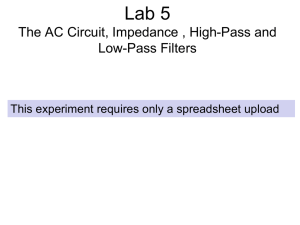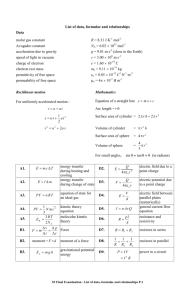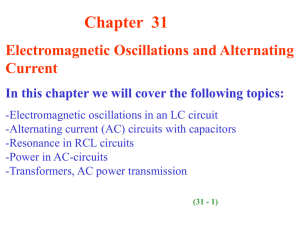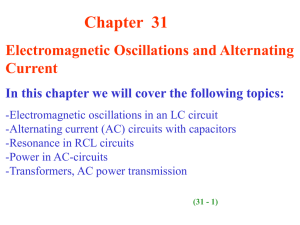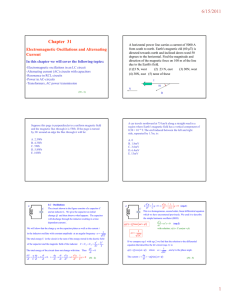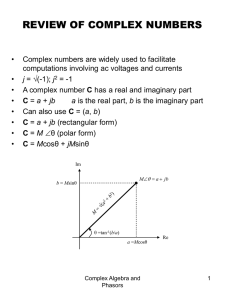Phys 345 Electronics for Scientists
advertisement
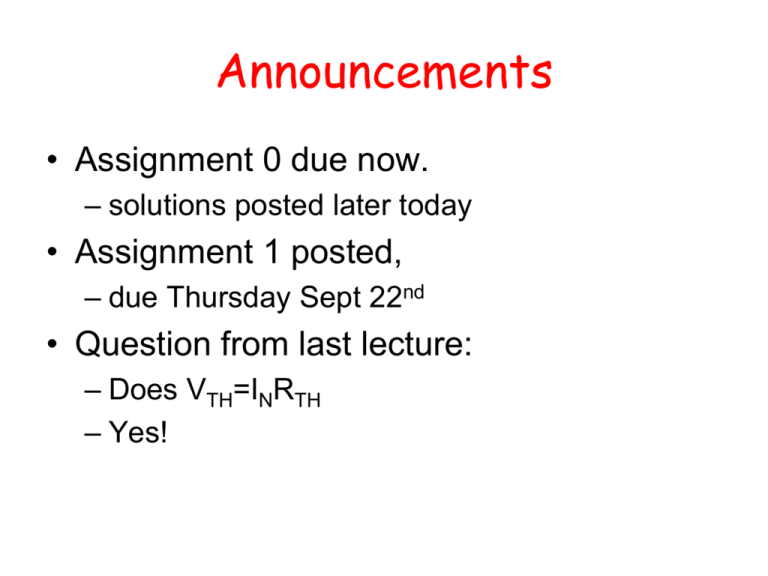
Announcements • Assignment 0 due now. – solutions posted later today • Assignment 1 posted, – due Thursday Sept 22nd • Question from last lecture: – Does VTH=INRTH – Yes! Lecture 5 Overview • Alternating Current • AC Components. • AC circuit analysis Alternating Current pure DC V • pure direct current = DC • Direction of charge flow (current) always the same and constant. pulsating DC V • pulsating DC • Direction of charge flow always the same but variable • AC = Alternating Current pulsating DC V V • Direction of Charge flow alternates -V AC Why use AC? The "War of the Currents" • Late 1880's: Westinghouse backed AC, developed by Tesla, Edison backed DC (despite Tesla's advice). Edison killed an elephant (with AC) to prove his point. • http://www.youtube.com/watch?v=RkBU3aYsf0Q • Turning point when Westinghouse won the contract for the Chicago Worlds fair • Westinghouse was right • PL=I2RL: Lowest transmission loss uses High Voltages and Low Currents • With DC, difficult to transform high voltage to more practical low voltage efficiently • AC transformers are simple and extremely efficient - see later. • Nowadays, distribute electricity at up to 765 kV AC circuits: Sinusoidal waves • Fundamental wave form • Fourier Theorem: Can construct any other wave form (e.g. square wave) by adding sinusoids of different frequencies • x(t)=Acos(ωt+) • f=1/T (cycles/s) • ω=2πf (rad/s) • =2π(Δt/T) rad/s • =360(Δt/T) deg/s RMS quantities in AC circuits • What's the best way to describe the strength of a varying AC signal? • Average = 0; Peak=+/• Sometimes use peak-to-peak • Usually use Root-mean-square (RMS) • (DVM measures this) I rms Ip 2 , Vrms Vp 2 , Pave I rmsVrms i-V relationships in AC circuits: Resistors Source vs(t)=Asinωt vR(t)= vs(t)=Asinωt iR (t ) vR (t ) A sin t R R vR(t) and iR(t) are in phase Complex Number Review Phasor representation 2 2 i-V relationships in AC circuits: Resistors Source vs(t)=Asinωt vR(t)= vs(t)=Asinωt iR (t ) vR (t ) A sin t R R vR(t) and iR(t) are in phase Complex representation: vS(t)=Asinωt=Acos(ωt-90)=real part of [VS(jω)] where VS(jω)= A[cos(ωt-90)-jsin(ωt-90 )]=Aej (ωt-90) Phasor representation: VS(jω) =A(ωt-90) IS(jω)=(A/R) (ωt-90) Impedance=complex number of Resistance Z=VS(jω)/IS(jω)=R Generalized Ohm's Law: VS(jω)=ZIS(jω) http://arapaho.nsuok.edu/%7Ebradfiel/p1215/fendt/phe/accircuit.htm Capacitors What is a capacitor? Definition of Capacitance: C=q/V Capacitance measured in Farads (usually pico - micro) Energy stored in a Capacitor = ½CV2 (Energy is stored as an electric field) In Parallel: V=V1=V2=V3 q=q1+q2+q3 q q1 q2 q3 Ceq C1 C2 C3 V V i.e. like resistors in series Capacitors In Series: V=V1+V2+V3 q=q1=q2=q3 1 V V1 V2 V3 1 1 1 Ceq q q C1 C2 C3 i.e. like resistors in parallel No current flows through a capacitor In AC circuits charge buildup/discharge mimics a current flow. A Capacitor in a DC circuit acts like a break (open circuit) Capacitors in AC circuits Capacitive Load vC A sin t qC CvC dqC CA cos(t ) dt VC ( j ) A(t 90) iC I C ( j ) CA(t 0) ZC VC ( j ) 1 90 C I C ( j ) cos( 90) j sin( 90) j j j. j 1 C jC jC "capacitive reactance" • Voltage and current not in phase: • Current leads voltage by 90 degrees (Physical - current must conduct charge to capacitor plates in order to raise the voltage) • Impedance of Capacitor decreases with increasing frequency http://arapaho.nsuok.edu/%7Ebradfiel/p1215/fendt/phe/accircuit.htm Inductors What is an inductor? Definition of Inductance: vL(t)=-LdI/dt Measured in Henrys (usually milli- micro-) Energy stored in an inductor: WL= ½ LiL2(t) (Energy is stored as a magnetic field) • Current through coil produces magnetic flux • Changing current results in changing magnetic flux • Changing magnetic flux induces a voltage (Faraday's Law v(t)=-dΦ/dt) Inductors Inductances in series add: Inductances in parallel combine like resistors in parallel (almost never done because of magnetic coupling) An inductor in a DC circuit behaves like a short (a wire). Inductors in AC circuits Inductive Load vS A sin t vL L diL dt A sin t L (back emf ) diL dt from KVL A A iL sin tdt cos t L L A A iL sin( t 90) cos(t 180) L L VL ( j ) A(t 90) A (t 180) L V ( j ) ZL L L90 I L ( j ) cos(90) j sin( 90) j Z L jL I L ( j ) • Voltage and current not in phase: • Current lags voltage by 90 degrees • Impedance of Inductor increases with increasing frequency http://arapaho.nsuok.edu/%7Ebradfiel/p1215/fendt/phe/accircuit.htm AC circuit analysis • Effective impedance: example • Procedure to solve a problem – – – – Identify the sinusoid and note the frequency Convert the source(s) to complex/phasor form Represent each circuit element by it's AC impedance Solve the resulting phasor circuit using standard circuit solving tools (KVL,KCL,Mesh etc.) – Convert the complex/phasor form answer to its time domain equivalent Example ( Z R1 Z C ) I1 ( j ) Z C I 2 ( j ) VS ( j ) Z C I1 ( j ) ( Z C Z L Z R 2 ) I 2 ( j ) 0 VS ( j ) ZC 0 ZC Z L Z R2 ( Z C Z L Z R 2 )VS ( j ) I 1 ( j ) 2 Z R1 Z C ZC ( Z R1 Z C )( Z C Z L Z R 2 ) Z C ZC ZC Z L Z R2 1 1 66.7 66.7 j () 6 jC j1500 10 j Z L jL j1500 0.5 750 j () ZC (75 683 j )150 I1 ( j ) (100 66.7 j )(75 683 j ) 4450 (75 683 j )150 I1 ( j ) (100 66.7 j )(75 683 j ) 4450 Top: Bottom: (75 683 j )150 68783.7 150 tan 1 b 683 tan 1 83.7 a 75 A a 2 b 2 687 (100 66.7 j )(75 683 j ) 4450 7500 45600 5000 j 683 j 4450 57550 63300 j 8550047.8 68783.7 150 I 1 ( j ) 8550047.8 0.1235.9 0.120.63 radians i1 (t ) 0.12 cos(1500t 0.63) Amps
